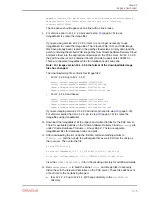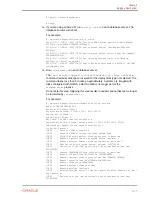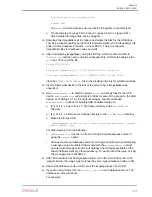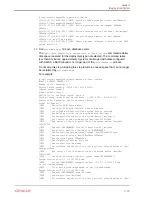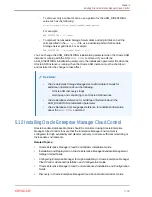
5.9 Performing Initial Elastic Configuration of Oracle
Exadata Database Machine
This topic provides background information on elastic configuration and describes how
to perform the initial configuration of Oracle Exadata Database Machine.
You need the configuration file generated by Oracle Exadata Database Machine
Deployment Assistant.
Elastic configuration is new in Exadata version 12.1.2.1.0. It applies to all rack
configurations, such as the following:
•
Racks ordered with a standard number of database nodes and cells, for example,
quarter or half racks
•
Rack configurations that feature additional database nodes and cells
•
Oracle Exadata Database Machine Two-Socket X5 generation and later Storage
Servers
Starting with the Oracle Exadata Database Machine Two-Socket X5 generation of
Storage Servers, the same process can also be used to add additional database
servers or cells to an existing configuration.
The process allows initial IP addresses to be assigned to database servers and cells,
regardless of the exact customer configuration ordered. The customer specific
configuration can then be applied to the nodes. The procedure can be run from any
database node (usually the first node,) and also from a cell in cases where expansion
involves adding only cell nodes.
Every Exadata system has a pre-defined method for the cabling of nodes to the
InfiniBand switch ports. Therefore, there is a fixed mapping from each node's location
in the rack to the ports of the InfiniBand switches. Assuming the rack is always
populated following this map, a node's rack unit location can be identified by querying
the InfiniBand fabric to determine the InfiniBand switch port the node is connected to.
Once found, that information is used to determine the rack unit location of the node.
With this information, nodes can be allocated initial IP addresses based on their rack
unit location, with nodes lower in the rack getting lower IP addresses.
Note:
•
If a RAID rebuild/reconstruction (that is, a disk replacement or expansion)
is in progress, wait until it is finished before performing the steps in this
section. The reason is that the
reclaimdisks.sh
script is blocked from
running until the RAID rebuild/reconstruction is complete.
•
Disk space for unused system partitions must be reclaimed before
installing software. Use the following script to reclaim the disk space:
/opt/oracle.SupportTools/reclaimdisks.sh -free -reclaim
•
My Oracle Support note 1953915.1 for detailed information about the
configuration process.
Chapter 5
Performing Initial Elastic Configuration of Oracle Exadata Database Machine
5-85





